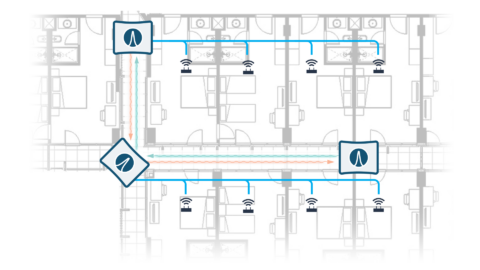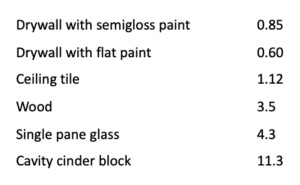The unlicensed V-band is gaining significant attention for its potential to blast through walls. Initially targeted for residential broadband, interest has shifted towards in-building wireless backbones. This shift is driven by the V-band’s strengths: a vast amount of available spectrum (14 GHz in the U.S.) and the ability to achieve high spectral reuse with beamforming technology. However, the band also has weaknesses. Range is limited due to oxygen absorption, and it struggles with foliage and rain. While these limitations are irrelevant indoors, obstructions within buildings can still pose challenges.
In-Building Obstructions and Mitigation Techniques
 The list of in-building obstructions includes people, walls, furniture, and equipment. One way to mitigate this problem is to mount the radios just below the ceiling, which eliminates everything except for the walls.
The list of in-building obstructions includes people, walls, furniture, and equipment. One way to mitigate this problem is to mount the radios just below the ceiling, which eliminates everything except for the walls.
Common building materials include sheetrock (aka drywall), wood, glass, brick, stone, metal, and concrete. Sheetrock is found in all modern office buildings, but the others will also be present in many cases. A sheetrock wall is fairly transparent to 60 GHz signals and usually consists of two 5/8 inch pieces of gypsum separated by an air gap of about 4 inches. That gap is often filled with soundproofing material, but these substances are not dense and are easily penetrated.
Places where you might run into metal include elevator shafts that are usually in the center of the building. Glass can be divided into an interior single-pane glass that is easily penetrated and exterior dual-pane glass with a metallic coating that is almost impenetrable to 60 GHz signals. The latter is a good thing as it prevents interior RF from escaping the work area, and exterior RF from entering the work area.
Designing Solutions for In-Building Wireless Systems
So, what is to be done when designing an in-building wireless backbone when obstructions are present?
We can address obstructions in two ways. The first option involves using a system that actively routes around them. This is best achieved with a dual counter-rotating wireless ring configuration, like the Airvine WaveTunnel system described below.

WaveTunnel nodes take center stage in this scenario. They actively pick up traffic from nearby Wi-Fi 6/6E access points while simultaneously relaying traffic from neighboring nodes. This strategic positioning allows the network to bypass significant obstructions, like elevator shafts, by cleverly routing traffic around them. Additionally, the signal relaying function combats signal attenuation, enabling the system to cover a vast area at a minimal cost.
For obstructions that can’t be bypassed, we have another option: brute force! We can blast right through walls with a system that boasts a sufficient link budget to handle the additional attenuation. (Option #2)
Material Challenges and WaveTunnel Technology Efficacy
A lot of work has been done over the years to categorize V-band signals as they pass through different building materials.

Certain building materials are easy to pass through such as sheetrock, plywood, and single-pane glass, and others are far more problematic. In our testing, nothing was more challenging than concrete (cavity cinder block) which provided 11.3 dB of attenuation per centimeter or about 45 dB per block.
WaveTunnel technology boasts the muscle to punch through a variety of wall materials when routing isn’t an option. This brawn comes courtesy of two key advantages: operating indoors where range (and Free Space Path Loss) is minimized, and wielding a super high-gain beamforming antenna. The narrower the beam (think pencil-thin), the higher the gain, and the more power it packs to BLAST THROUGH WALLS!
For more on Airvine technology and the All-Wireless Enterprise please visit us online.
Originally Posted on April 29, 2021 by Steve Hratko